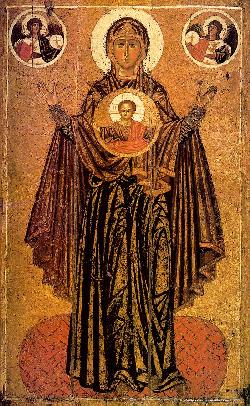
Kiev School. Ca. 1114 (?)
Tretiakov Gallery, Moscow, 194 x 120 cm.

 This image of the All-Holy Virgin in Orans pose, with hands reaching upwards, replicates the common iconographical type of the Virgin found in many Eastern Orthodox churches in the apse of the sanctuary, where it symbolically relates to her position as an intercessor between people and Christ. The Kiev Panagia is a splendid example of monumental composition characteristic of the early period of Russian icon painting. The icon is strongly influenced by the Byzantine art of the period, particularly in the solemn and static posture, in the folds of the garments, and in the pensive look on the Virgin's face. It is possible that this icon was inspired by a mosaic (see the Orans in the Cathedral od St. Sophia in Kiev).
This image of the All-Holy Virgin in Orans pose, with hands reaching upwards, replicates the common iconographical type of the Virgin found in many Eastern Orthodox churches in the apse of the sanctuary, where it symbolically relates to her position as an intercessor between people and Christ. The Kiev Panagia is a splendid example of monumental composition characteristic of the early period of Russian icon painting. The icon is strongly influenced by the Byzantine art of the period, particularly in the solemn and static posture, in the folds of the garments, and in the pensive look on the Virgin's face. It is possible that this icon was inspired by a mosaic (see the Orans in the Cathedral od St. Sophia in Kiev).
The composition is extremely balanced, almost symmetrical. On either side of the Virgin's head are two archangels who seem to be looking over her and perhaps expressing astonishment at the great miracle of Christ's birth. Christ is shown in a roundel on the Virgin's chest to indicate symbolically that he is in her womb: "Behold, a virgin shall conceive, and bear a son, and shall call his name Immanuel" (KJV, Isaiah 7:14). Notice how the hands of Christ Emmanuel, stretched out in blessing, connect to the hands of the Virgin. The roundels with the archangels, the halo of the Virgin, and the roundel containing the image of Christ form a triangle, and this triangular shape, "framed" by the position of the Virgin's hands and a particularly deep crease in the folds of her garment, pushes the Virgin's body down and anchors it firmly to the decorative red ground. The mantle falls down at an angle which counteracts the downward push of the triangle and balances the composition. The folds of the drapery define her body, but they seem to disconnect her from her feet. The gold background helps to accentuate the red of the ground and the browns and blues of the cloak. [K.T. and A.B.]
